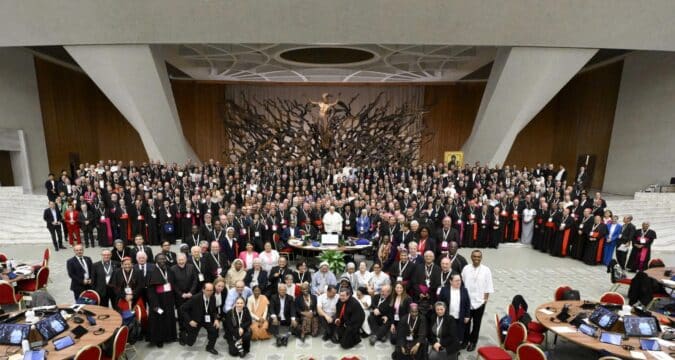
Father Joseba Kamiruaga Mieza, CMF
“It is not working. It is not taking off.”
That is my honest feeling when I look at the Synod on Synodality and the current state of our Church. The dream was bold, the vision compelling: a Church walking together, discerning together, listening together. But the reality, at least for now, feels much more complex, weighed down by inertia and old habits.
A Church slow to change
To ask whether synodality is a revolution or a reform may miss the point. The deeper question is whether the Church is even capable of embracing this new way of being. For centuries, Catholics have debated the need for reform: changes in the Roman Curia, new norms on sexuality and relationships, the role of women, the discipline of celibacy, and more. Synodality was supposed to address not just these particular issues but the very style of how we journey together.
Yet, the Church at its core remains deeply tied to structures that resist change. The Catholic Church, like any vast institution, tends toward preservation. It is solidly organised, tightly disciplined, hierarchically structured, and staffed by nearly half a million full-time officials trained in specialised institutions. It possesses a vast patrimony of property and wealth, all designed to endure.
But with endurance comes inertia. Over time, this institution has developed pathologies: difficulty in adapting, excessive attachment to formalism, and a tendency for its leaders to see themselves as part of a privileged corps. Too often, means are confused with ends, and the survival of the institution overshadows its founding mission.
To ask whether synodality is a revolution or a reform may miss the point. The deeper question is whether the Church is even capable of embracing this new way of being
The pope’s dilemma
On paper, the Catholic Church is unique among global institutions. It has a leader elected for life who possesses extraordinary powers to change everything. A pope could, in theory, revolutionise the very face of the Church. However, in practice, even the pope is constrained by history, culture, and the immense institutional weight that presses upon him.
Pope Francis may have considered pushing harder. But like his predecessors, he has felt the need to preserve the system entrusted to him, to maintain a delicate balance. The result? A non-decision that keeps the system intact, even as the slogans proclaim, “It is time for synodality” or “Synodality is the DNA of the Church.”
This is why synodality feels stuck. The will may be there, but the machinery resists. The desire for change is real, but the structure tends to default to self-preservation.
Secularisation and the limits of reform
Meanwhile, outside the Church, secularisation continues its steady march. In regions like Western Europe, churches are emptying, and citizens are distancing themselves, not only from Catholicism but from religion itself.
And here lies a paradox: whether churches embrace reforms or resist them, the trend is the same. Protestant communities that ordain women or recognise same-sex marriage also see declining numbers. Secularisation acts as a great leveller, weakening all denominations alike.
A pope could, in theory, revolutionise the very face of the Church. However, in practice, even the pope is constrained by history, culture, and the immense institutional weight that presses upon him
This means that reform alone is not enough to win back those who have drifted away. Sometimes, in fact, religious institutions seem to double down on distinctiveness, emphasising their differences from modern society in order to maintain identity. In a polarised world, this creates cultural and spiritual ghettos—smaller, more sectarian communities that survive by holding tightly to what sets them apart.
Identity or innovation?
This tension defines the Church today. On one side is the call to open up, to be synodal, to walk together in new ways. On the other side is the instinct to preserve identity, to protect what has endured for centuries, and to resist becoming too “modern.”
The danger is clear: if reforms go too far, the Church risks losing its identity and alienating those who seek stability. But if reforms stall, the Church risks becoming an empty shell—well-structured, wealthy, and organised, but devoid of believers.
What is left, then, of the original spirit of Jesus and his disciples? What remains of that band of friends, poor and itinerant, proclaiming the Kingdom with joy and freedom? What of the Spirit’s “conspiracy,” that radical openness to God’s future?
But if reforms stall, the Church risks becoming an empty shell—well-structured, wealthy, and organised, but devoid of believers
Perhaps I am being too harsh. Perhaps time will prove that synodality is indeed “taking off,” slowly but surely. But for now, I can only share my sense, rooted in what I observe: synodality is not working. It is not taking off.
This does not mean the effort is meaningless. The synod has sparked conversations, awakened hope, and made visible the longing of many faithful for a more participatory Church. But institutional inertia remains strong, and secularisation continues to erode religious belonging in ways that reforms alone cannot stop.
At the crossroads
The Church stands at a crossroads. It can cling to survival, maintaining its patrimony, its rituals, its structures, and perhaps shrink into a sectarian enclave. Or it can dare to risk the synodal path, trusting the Spirit, even if that means letting go of old securities.
I cannot predict which path will prevail. But I do know this: synodality is not just a slogan. It is a call to rediscover the very heart of the gospel—relationship, listening, walking together as friends of Christ.
That vision may still ignite. It may still surprise us. The Spirit, after all, is not bound by our structures or fears.
For now, though, I share simply a feeling. Synodality has not yet taken flight. The question is not whether synodality will take off, but whether we, as Church, are willing to leave the runway.








